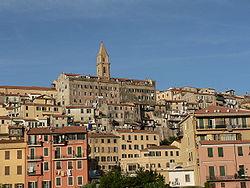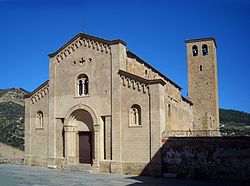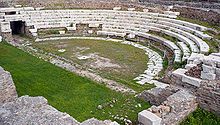- Ventimiglia
-
For other uses, see Ventimiglia (disambiguation).
Ventimiglia — Comune — Città di Ventimiglia Panorama of Ventimiglia 
Coat of armsLocation of Ventimiglia in Italy Coordinates: 43°47′N 7°37′E / 43.783°N 7.617°E Country Italy Region Liguria Province Imperia (IM) Frazioni Grimaldi, Mortola Inferiore, Mortola Superiore (i Ciotti), Latte, Carletti, Sealza, Sant'Antonio, Villatella, Ville, Calandri, San Lorenzo, San Bernardo, Seglia, Bevera, Calvo, San Pancrazio, Torri, Varase, Roverino, Porra, Trucco, Verrandi Government – Mayor Gaetano Scullino Area – Total 54.01 km2 (20.9 sq mi) Elevation 9 m (30 ft) Population (30 April 2009) – Total 25,763 – Density 477/km2 (1,235.4/sq mi) Demonym Ventimigliesi Time zone CET (UTC+1) – Summer (DST) CEST (UTC+2) Postal code 18039 Dialing code 0184 Patron saint San Secondo Saint day 26 August Website Official website Ventimiglia[1] (Italian: Ventimiglia, French: Vintimille) is a city and comune in Liguria, northern Italy, in the province of Imperia. It is located 130 km (80.78 mi) southwest of Genoa by rail, and 7 km from the French-Italian border, on the Gulf of Genoa, having a small harbour at the mouth of the Roia River, which divides the town into two parts. Ventimiglia's urban area has a population of 55,000.
Contents
History
Ventimiglia is the ancient Albium Intemelium, the capital of the Intemelii, a Ligurian tribe which long resisted the Romans, until in 115 BC it was forced to submit to Marcus Aemilius Scaurus. In 69 the city was sacked by the army of Otho and Vitellius but recovered to remain prosperous into the fifth century, surrounded by walls with cylindrical towers built at each change of direction.
In the Gothic Wars it was besieged by the Byzantines and the Goths, and later suffered from the raids of Rothari, King of the Lombards, but flourished again under Rodoald. After the fall of Charlemagne's empire, Berengar II of Italy made his son Conrad first Count of Ventimiglia. In the tenth century it was attacked by the Saracens of Frassinetto. After a period as an independent commune, it was ruled by the Counts of Ventimiglia, which had often to fight with the Republic of Genoa.
In 1139 the Genoese attacked it by land and sea and forced it to surrender; the count continued to hold the city and countship as a vassal of the victors. The city rebelled more than once against the Genoese and sided with their enemies. In 1271 in a war with Genoa its podestà Luca Grimaldi was captured. Ventimiglia was thus temporarily held by the dukes of Savoy (1389 and 1746) and King Ladislaus of Naples (1410). In 1505 it was annexed to the Genoese Republic, sharing its history until the early 19th century.
Main sights
Remains of a Roman theatre (first half of the 2nd century) are visible, and remains of many other buildings have been discovered, among them traces of the ancient city walls, a fine mosaic, found in 1852 but at once destroyed, and a number of tombs to the west of the theatre. The ruins of the ancient Albintimilium are situated in the plain of Nervia, c. 5 km to the east of the modern town.
The caves of the Balzi Rossi have proved rich in palaeolithic remains of the Quaternary period. Remains of a family of Cro-Magnon people were discovered, with several skeletons of men, women and children.
Very important architecturally and historically is the ancient medieval city centre, perched on a hill overlooking the new town.
The Church of San Michele Arcangelo was erected in the 10th century by the Counts of Ventimiglia on the foundations of a pagan temple. Later it was entrusted to the Benedictins of Lirins. In the 11th-12th centuries it was remade in Romanesque style. In 1628 it lost the aisles after an earthquake. It houses two milestones from the old Via Iulia Augusta, two of which are used as stoups and one supports the crypt's vault.
The present Romanesque Cathedral, with an 11th-century baptistery, is built on the ruins of an earlier Lombard church, and this again on a Roman building, possibly a temple.
The municipal library has the second largest collection of manuscripts and books written during the 17th century in Italy (the biggest collection is in Venice).
The Giardini Botanici Hanbury (Hanbury Botanical Gardens), surrounding the splendid villa of Sir Thomas Hanbury, La Mortola, are the biggest in Italy and among the finest in Europe, boasting many varieties of tropical and sub-tropical species that thrive in this mild climate.
Near to Ventimiglia are the Genoese fortresses of Castel d'Appio, Forte San Paolo and Fortezza dell'Annunziata.
Tourism
Ventimiglia is a popular destination during the summer for tourists spending their vacation along the French Riviera. Particularly popular all year with visitors from France is the Friday street market, which takes place along the seafront of the new town, and is a cause of major traffic congestion.
Transportation
It is located on the Via Aurelia Provincial Road, and has a gate on the A10 Motorway. It has two railway stations, the main station on the line from Genoa to France and one on the line to Cuneo.
International relations
See also: List of twin towns and sister cities in ItalyTwin towns - Sister cities
Ventimiglia is twinned with:
 Piazza Armerina, Sicily
Piazza Armerina, Sicily
See also
- Diocese of Ventimiglia
- Seborga
References
Sources
 This article incorporates text from a publication now in the public domain: Chisholm, Hugh, ed (1911). Encyclopædia Britannica (11th ed.). Cambridge University Press.
This article incorporates text from a publication now in the public domain: Chisholm, Hugh, ed (1911). Encyclopædia Britannica (11th ed.). Cambridge University Press.
External links
- Official website (Italian)
- Richard Stillwell, ed. Princeton Encyclopedia of Classical Sites, 1976: "Albintimilium (Ventimiglia), Liguria, Italy"
Liguria · Comuni of the Province of Imperia Airole · Apricale · Aquila d'Arroscia · Armo · Aurigo · Badalucco · Bajardo · Bordighera · Borghetto d'Arroscia · Borgomaro · Camporosso · Caravonica · Carpasio · Castellaro · Castel Vittorio · Ceriana · Cervo · Cesio · Chiusanico · Chiusavecchia · Cipressa · Civezza · Costarainera · Diano Arentino · Diano Castello · Diano Marina · Diano San Pietro · Dolceacqua · Dolcedo · Imperia · Isolabona · Lucinasco · Mendatica · Molini di Triora · Montalto Ligure · Montegrosso Pian Latte · Olivetta San Michele · Ospedaletti · Perinaldo · Pietrabruna · Pieve di Teco · Pigna · Pompeiana · Pontedassio · Pornassio · Prelà · Ranzo · Rezzo · Riva Ligure · Rocchetta Nervina · San Bartolomeo al Mare · San Biagio della Cima · San Lorenzo al Mare · Sanremo · Santo Stefano al Mare · Seborga · Soldano · Cosio di Arroscia · Taggia · Terzorio · Triora · Vallebona · Vallecrosia · Vasia · Ventimiglia · Vessalico · Villa FaraldiCategories:- Cities and towns in Liguria
- Communes of the Province of Imperia
- Roman towns and cities in Italy
- Italian Riviera
- Castles in Italy
Wikimedia Foundation. 2010.




